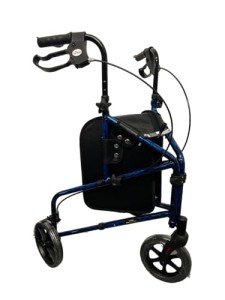The 10 Most Scariest Things About Medical Walker
페이지 정보

본문
Understanding Medical Walkers: A Comprehensive Guide
Medical walkers work as important mobility aids for people recuperating from surgical treatment, managing chronic illnesses, or handling age-related mobility concerns. These devices not just boost physical self-reliance but likewise enhance safety, enabling users to navigate their environments with higher ease. This post explores the types, benefits, functions, and considerations connected with medical walkers, along with some frequently asked questions.

Table of Contents
- Kinds Of Medical Walkers
- Benefits of Using a Medical Walker
- Secret Features to Consider
- Often Asked Questions
- Conclusion
1. Kinds Of Medical Walkers
Medical walkers are available in different designs, catering to different requirements and preferences. The primary types include:

| Type of Walker | Description |
|---|---|
| Standard Walker | A rectangle-shaped frame with four legs, providing stability and support. |
| Two-Wheeled Walker | Similar to a basic walker however equipped with wheels at the front for much easier movement. |
| Three-Wheeled Walker | A lightweight walker with 3 wheels, permitting for more maneuverability, perfect for indoor use. |
| Rollator Walker | A walker with four wheels, hand brakes, and a seat, ideal for longer ranges and resting requirements. |
| Hemi Walker | Developed for individuals who can use just one hand, featuring a tripod-like design. |
2. Benefits of Using a Medical Walker
Utilizing a medical walker provides numerous benefits that contribute to the user's overall wellness, including:
- Increased Stability: Walkers supply a steady base of support, lowering the risk of falls.
- Enhanced Mobility: They enable users to walk around more quickly, promoting independence.
- Pain Relief: By redistributing weight, walkers can minimize pain in the joints, particularly in the hips and knees.
- Posture Support: These gadgets encourage correct posture, decreasing stress on the back.
- Improved Confidence: Users frequently feel more safe and secure utilizing walkers, causing much better self-confidence and increased activity levels.
3. Secret Features to Consider
When picking a medical walker, it's important to assess various features to discover the ideal fit. Here are some crucial elements to consider:
- Weight Capacity: Ensure the walker can support the user's weight while maintaining stability.
- Height Adjustment: Look for a walker with adjustable height settings to accommodate the user's height and offer comfy grip.
- Material: Lightweight aluminum walkers are much easier to navigate, while steel walkers use stronger assistance but may be much heavier.
- Wheel Quality: If choosing a wheeled walker, consider the wheel size and tread. Bigger wheels navigate uneven surface areas more easily.
- Seat Availability: If users will be walking for longer periods, a walker with an integrated seat can supply rest breaks when needed.
- Brakes: Hand brakes are particularly crucial for safety in rollator walkers to manage speed and stop when needed.
Kinds of Walkers with Features Comparison Table
| Walker Type | Weight Capacity | Height Adjustment | Wheels | Seat Available | Brakes |
|---|---|---|---|---|---|
| Requirement Walker | Approximately 300 pounds | Yes | No | No | No |
| Two-Wheeled Walker | Approximately 300 pounds | Yes | Yes | No | No |
| Three-Wheeled Walker | Approximately 250 lbs | Yes | Yes | No | No |
| Rollator Walker | Approximately 400 pounds | Yes | Yes | Yes | Yes |
| Hemi Walker | Up to 250 pounds | Yes | No | No | No |
4. Often Asked Questions
Q1: Who need to use a medical walker?A: Medical walkers are beneficial for people recovering from surgical treatment, experiencing balance issues, or needing help due to age-related mobility challenges. Q2: Can a medical walker be adjusted?A: Yes, most
medical walkers are height-adjustable to accommodate various user heights, enabling a more comfy grip. Q3: How do I select the best walker for my needs?A: Consider elements such as the
user's weight, height, type of mobility concerns, and whether they need a seat or brakes. Checking the walker for convenience and stability before purchase is also advisable. Q4: Are there any safety suggestions connected with utilizing a medical walker?A: Yes, users ought to ensure they don't lean too
greatly on the walker, use it on steady and level surfaces, and constantly make sure
the brakes are engaged when seated or fixed. Q5: Can walking with a medical walker assistance with rehabilitation?A: Absolutely. Medical walkers are frequently recommended as part of rehab programs as they motivate
exercise, which aids in recovery and mobility improvement. 5.
Conclusion Medical walkers play an essential function in boosting the quality of life for people dealing with mobility challenges. With various types and functions available, selecting the ideal walker involves thinking about the user's specific requirements and scenarios. By comprehending their benefits and proper use, people can gain back self-reliance, enhance their mobility, and browse their environments safely. Whether for short-term recovery or long-lasting assistance, the best medical walker can substantially boost a user's total wellness. Incorporating a medical walker into one's day-to-day routine can be a transformative decision, making it much easier to take part in life's daily activities while guaranteeing safety and self-confidence.
- 이전글The Most Pervasive Issues With Order Fake Currency 25.06.18
- 다음글It Is The History Of Preparation For Exam Online In 10 Milestones 25.06.18
댓글목록
등록된 댓글이 없습니다.

